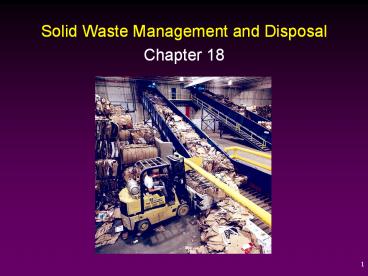Solid Waste Management and Disposal - PowerPoint PPT Presentation
Title:
Solid Waste Management and Disposal
Description:
Solid Waste Management and Disposal Chapter 18 * iRespond Question Master A.) Response A B.) Response B C.) Response C D.) Response D E.) Response E Percent Complete ... – PowerPoint PPT presentation
Number of Views:3197
Avg rating:3.0/5.0
Title: Solid Waste Management and Disposal
1
Solid Waste Management and Disposal
- Chapter 18
2
Kinds of Solid Waste
- ___________ is generally made of objects or
particles that accumulate ___________where they
are produced. - Typically categorized by the ____________
responsible for producing them. - Mining Wastes
- Waste Material ____________
- Milling Tailings
- Waste or Tailings __________
- Agricultural Waste
- Includes _____________________as well as crop and
tree ___________. - 90 is used as ___________ or other forms of soil
enhancement.
3
Kinds of Solid Waste
- Industrial Solid Waste - Solid waste other than
mining. - Estimated 180-540 million tons annually.
- ____________ Waste
- Sludge
- Combustion _____
- Municipal Solid Waste
- All the materials ________________________________
_. - 230 million tons annually.
- In modern society, many products are discarded
when they are broken or worn out, while others
_______________________. - Those that have only temporary uses make up the
majority of solid waste. - Unites States produces about _______________of
municipal solid waste annually. - Equates to 2 kg of trash person / day.
- Per capita waste has increased 70 since 1960.
4
Municipal Solid Waste
- In modern society, many products are discarded
when they are broken or worn out, while others
only have a temporary use. - Those that have only temporary uses make up the
majority of solid waste. - Unites States produces about 230 million tons of
municipal solid waste annually. - Equates to 2 kg of trash person / day.
- Per capita waste has increased _______________.
5
Waste Generation and Lifestyle
- Nations with a _____________________ tend to
produce more municipal solid waste per person
than less-developed countries. - Large metropolitan areas have the greatest
difficulty dealing with solid waste. - Traditional Methods (__________________) no
longer accepted.
6
Methods of Waste Disposal
- Landfills
- Municipal solid waste landfill typically a
____________________________, lined with
impermeable membrane. - Each days deposit of fresh garbage is
____________________to prevent it from blowing
around and to discourage animal scavengers. - Traditionally been primary method of waste
disposal. - Cheap and Convenient
7
Landfills
- New landfills have ________________to trap
contaminant-laden __________. - Monitoring systems are necessary to detect
_________production and _______________________. - In some cases, methane collected and used to
_________________. - Currently cost up to 1 million per hectare to
prepare.
8
Modern Landfill
9
Landfills
- Number of landfills is __________.
- Many small landfills ____________
- __________
- Capacity has been reached.
- New landfills often resisted due to
__________________________________________________
______________ - Politicians are often unwilling to take strong
positions that might alienate constituents.
10
Reducing the Number of Landfills
11
Incineration
- Currently, about 15 of U.S. municipal solid
waste is _________. - Production of __________ partially offsets
disposal ________. - Most incinerators burn unprocessed municipal
solid waste. - Mass Burn
12
Incineration
- Incinerators ______________the amount of
municipal waste. - Up to 90 by volume and 75 by weight.
- Primary risks of incineration________________
- ________________________________________________
- Even with modern pollution controls, small
amounts of pollutants still released into
environment - ________________________for new incinerators are
also major concerns facing many communities. - Construction costs in North America in 2000
ranged from __________________. - U.S. EPA has not looked favorably on construction
of new waste-to-energy facilities. - Encouraged ______________________as more
effective solutions to deal with solid waste.
13
Producing Mulch and Compost
- Mulch is ____________used to protect areas where
the soil is disturbed, or to control growth of
unwanted vegetation. - Organic material _____________________into
smaller pieces. - Composting is using ______________________
- _____________________________(humus-like
product). - With proper management of air and water,
composting can __________________over a short
period of time. - About 3,800 composting facilities currently in
use in the United States.
14
Diverting Waste Through Composting
15
Source Reduction
- Simplest way to reduce waste is to prevent it
from ever becoming waste in the first place. - Source reduction is the practice of
____________________ - ___________________________________so that the
amount of waste or its toxicity is reduced. - Design Changes
- Since 2-liter soft drink bottle introduced in
1977, weight has been reduced by 25. - Manufacturing Processes
- _______ waste, ________ efficiency.
- Purchasing Decisions
- Choose ____________and plan quantities
accordingly. - Reusing Items
- Delay or prevent entry of items into waste
collection stream.
16
Recycling
- In the United States, recycling (including
composting) diverted about 30 of solid waste
stream from landfills and incinerators in 2001. - Benefits
- Resource Conservation
- _________ Reduction
- Energy _________
- Job Creation
- __________for Landfills and Incinerators
17
Recycling
18
Recycling Programs
- Container Laws
- _______________on all reusable beverage
containers. - ______________would reduce litter, save energy
and money, create jobs, and help conserve natural
resources. - Mandatory Recycling Laws
- Provide statutory incentive to recycle.
19
Recycling Programs
- Curbside Recycling
- 1990 - __________ U.S. cities had __________
recycling programs. - Grown to ________ cities by 2000.
- Cities with curbside recycling tend to have
higher recycling rates than cities that lack such
programs.
20
Recycling Concerns
- Plastics are recyclable, _______________
- ________________________.
- Milk Container
- High-Density Polyethylene (HDPE)
- Egg Container
- Polystyrene (PS)
- Soft-Drink Bottle
- Poly-Ethylene Terephthalate (PET)
- http//lifecycle.plasticsresource.com/
21
Increasing Amounts of Plastic in Trash
22
(No Transcript)































